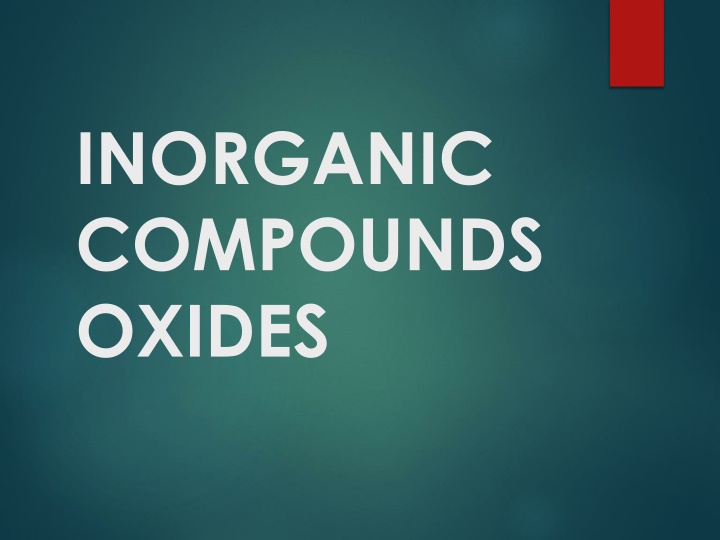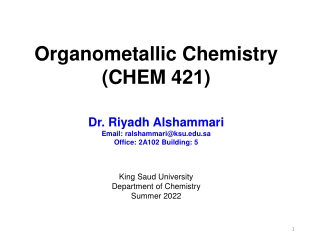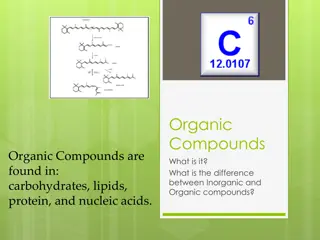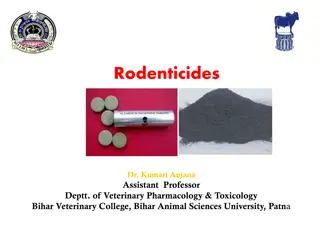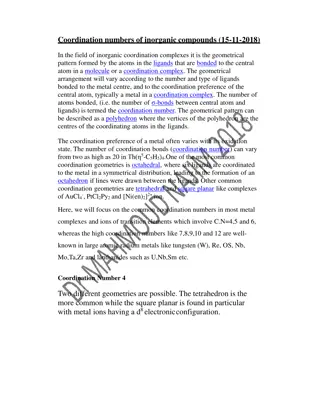Classification of Inorganic Compounds: Oxides & Chemical Compounds
Binary oxides, acid oxides, base oxides, amphoteric oxides, and neutral oxides are all part of the classification of inorganic compounds. Oxides can act as acids, bases, or both under different conditions, leading to the formation of salts and water. Naming of metal oxides depends on the oxidation state and type of metal present. Explore the reactivity and properties of various oxides in chemical compounds.
Download Presentation

Please find below an Image/Link to download the presentation.
The content on the website is provided AS IS for your information and personal use only. It may not be sold, licensed, or shared on other websites without obtaining consent from the author.If you encounter any issues during the download, it is possible that the publisher has removed the file from their server.
You are allowed to download the files provided on this website for personal or commercial use, subject to the condition that they are used lawfully. All files are the property of their respective owners.
The content on the website is provided AS IS for your information and personal use only. It may not be sold, licensed, or shared on other websites without obtaining consent from the author.
E N D
Presentation Transcript
INORGANIC COMPOUNDS OXIDES
Classification of the chemical compounds Chemical Compounds: Organic Inorganic: OXIDS ACIDS HYDROXIDES AND BASES SALTS COMPLEX COMPOUNDS
OXIDS Binary oxides represent compounds of oxygen (oxygen is bound to a metal, non-metal, semimetal) in which Oxidation number of oxygen is -2. Separation of oxides - according to properties: Acids, Bases, Amphoteric, Indifferent (neutral)
OXIDS Acid oxides are oxides that react with hydroxide (bases) or base oxides and thus form salts and water form acids. Example: (CO2, SO2, NO, P2O5) CO2 + Ca(OH)2 CaCO3 + H2O CO2+ CaO CaCO3 SO3+ H2O H2SO4 CO2+ H2O H2CO3 Acid oxides can arise with deprivation of water from acids, therefore still called anhydride acid (acid without water) Example: CO2 anhydride carbonic acid H2CO3 SO3 anhydrous sulfuric acid H2SO4
Oxides Base oxides are oxides that react with acids or acid form and oxides thereof and water form bases. For example:(CaO, Cu 2 O, CuO, Fe 2 O 3, ) CuO + H2SO4 CuSO4 + H2O CaO + CO2 CaCO3 CaO + H2O Ca (OH) 2 Na2O + H2O 2NaOH
Oxides Amphoteric oxides are oxides that under certain conditions apply as acid and basic oxides (react with acids and bases). : (ZnO, Al2O3, SnO, Sb2O3, PbO, .) ZnO + 2HCl ZnCl2 H2O + ZnO + 2NaOH + H2O = Na2 [Zn (OH) 4] Indifferent (neutral) oxides are those oxides which do not react with either acids or with bases or water. Example: (CO, NO, N2O, )
Oxides -Nomenclature oxides -Nomenclature of metal (base) oxide If metal built only one type oxide or metal if there is only one possible oxidation state, then the name of the oxide form of the name of the metal by adding the word "oxide". Example: Sodium oxide Na2O Calcium oxide CaO Aluminum oxide Al2O3 If the metal has more possible oxidation states (variable valence), that builds more kinds oxides, then between the name of the metal oxide and the word write the oxidation state of the metal with Roman number placed in parenthesis, merged with the name of the metal.
OXIDES examples: Cu2O copper (I) oxide CuO copper (II) oxide FeO iron (II) oxide Fe2O3 iron (III) oxide Look out! The name of the metal and the Roman numbers are merged write the name of the metal (with or without roman number) and write the word oxide separated. Nomenclature of non-metallic (acid) oxide Name of non-metal oxide in addition to the previous method, can be formed from the name of the metal and the word "oxide". Before the name of nonmetal before the word oxide are added prefixes that mark the appropriate stoichiometric index named in Greek
OXIDES examples: N2O5 dinitrogen pentoxide Sulfur trioxide SO3 P4O10 tetraphosphoric dekaoksid
OXIDES Being oxides Mainly oxides can be obtained in two ways: a.Direct bonding of elementary substance with oxygen Examples: 2Mg + O2 = 2MgO S + O2 = SO2 b. The decomposition of complex salts or compounds Examples: CaCO3 = CO2 + CaO
